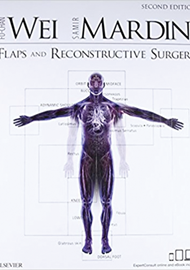This second edition of the popular Flaps and Reconstructive Surgery builds impressively on the first. Whilst the editors need little introduction, their expertise is supplemented by contributions from over 180 authors and world-renowned experts, providing a thoroughly comprehensive text.
Part 1, ‘Principles’, covers the basics of flap reconstruction before discussing tissue engineering, prefabrication and prelamination, percutaneous aponeurotomy and lipofilling (PALF), microsurgical management of lymphoedema and robotics in plastic surgery.
Part 2 discusses the relevant clinical anatomy and recipient vessel selection and exposure. These chapters neatly distill the essential anatomy by region, whilst the advantages and disadvantages of named vessels are discussed along with helpful technical tips.
In Part 3, ‘Reconstruction’, the principles of reconstruction, pre and postoperative considerations and the armamentarium of reconstructive flaps available for use are presented. Many of these chapters include a reconstructive algorithm to act as a guide for the surgeon faced with a defect in that anatomical region. Later chapters address technical aspects of microsurgery and include helpful chapters on re-exploration of flaps, avoiding complications and postoperative management of flap patients.
Parts 4 and 5 present a flap atlas divided into conventional and perforator-based workhorse flaps. Greatly expanded from the previous edition, nearly twice as many flaps are included, with detailed diagrams and photographs demonstrating key surface markings and steps in both flap raising and inset. Each chapter follows a similar structure, namely, relevant anatomy including vascular and nervous supply to the flap, preparation of the patient and flap design, operative positioning, modification, donor site management, technical tips, potential uses, postoperative management, complications and expected outcomes. To complete each chapter, brief clinical cases with accompanying photographs are presented. The final section, ‘Reconstructive transplant surgery’ covers the developing fields of face, hand, abdominal wall, laryngeal and uterine transplantation. Also included is a chapter on peripheral nerve allotransplantation and nerve conduits.
Additional chapters are available in the included eBook, along with over 150 narrated videos accessible online. Although somewhat expensive, this excellent updated text, well written and supported by high quality diagrams and photographs, would be a valuable reference for all surgeons involved in flap reconstruction.




